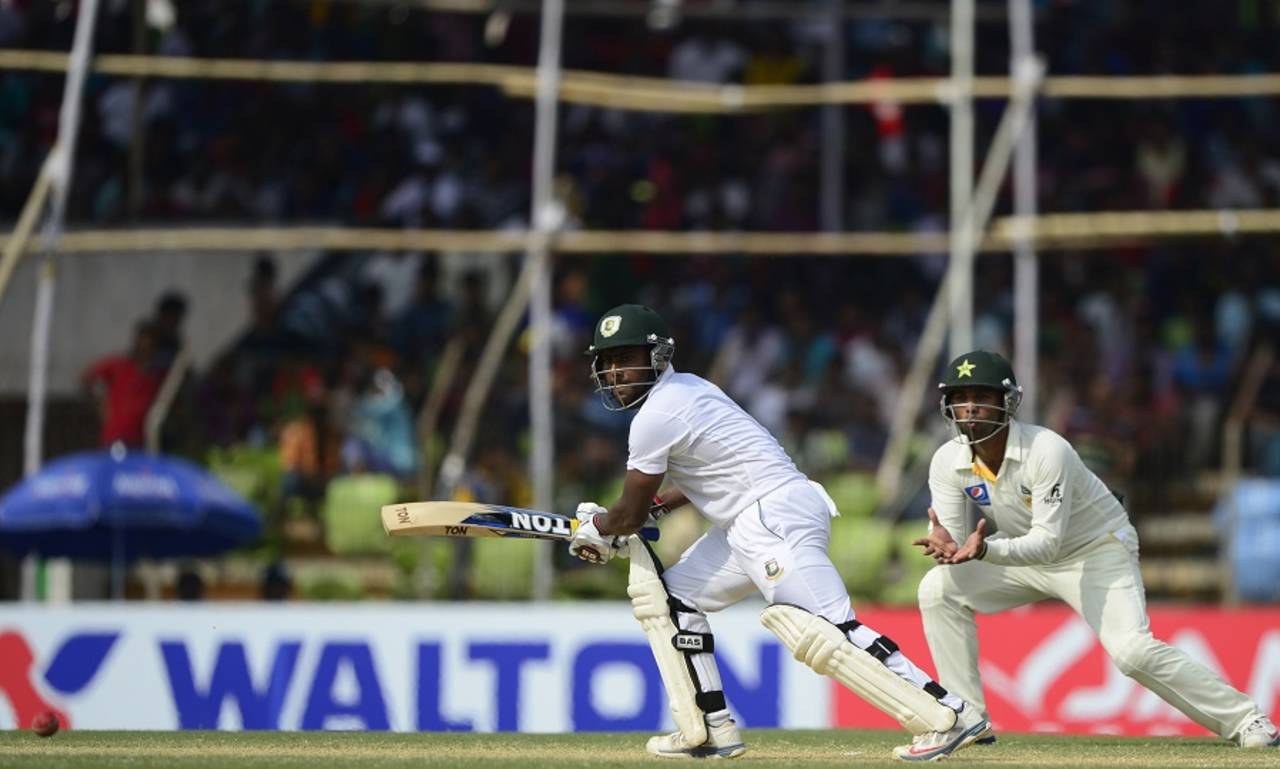Centurion Kayes overcomes wicketkeeping ordeal
Imrul Kayes had never kept wicket in international cricket before, but after 120 overs of standing behind the stumps, he came out and scored a century
Mohammad Isam in Khulna
02-May-2015

Imrul Kayes battled fatigue from standing in as wicketkeeper to score his third century • AFP
On the fourth morning of the Khulna Test, Imrul Kayes had enough. "I was feeling faint. I told Riyad bhai [Mahmudullah] that someone has to take over the gloves," he said. "I have to bat today. I need to gather my thoughts."
An hour into the fifth day, Imrul got out for 150. He and Tamim Iqbal had added the first 300-run opening partnership in the second innings of a Test, beating the 290 between England's Colin Cowdrey and Geoff Pullar in 1960, ensuring Bangladesh had the best platform in their quest for a draw.
Before he scored his third Test century and, with Tamim, changed the course of the match, Imrul had kept wicket for 120 overs from the second afternoon to the fourth morning because Mushfiqur Rahim was injured. It was his first time behind the stumps in international cricket, and he only vaguely remembers doing it before in a domestic tournament for a couple of overs. It left him physically drained.
"When Mushfiqur got injured, nobody knew who would be taking over his wicketkeeping duties," Imrul told ESPNcricinfo. "I volunteered ahead of others. I had kept wickets before in a few tournaments but never at this level. Then you know what happened. I stood behind for 120 overs and it was a lot of hard work. You realise what a wicketkeeper has to go through day in day out."
Imrul had the responsibility of opening Bangladesh's second innings, faced with a deficit of 296, having had less than an hour between giving the gloves to Mahmudullah and the end of Pakistan's first innings. Bangladesh had crumbled from such positions previously.
Imrul wasn't his usual self when he took the crease with Tamim and the Pakistan fielders reminded him of the burden he had shouldered. But when he walked off unbeaten on 132 at stumps on the fourth day, the ache in his body was forgotten for a few minutes.
"When I got to the crease, I wasn't thinking clearly," Kayes said. "I felt very weak, my body was aching. Tamim started to hit from the other end but I thought I would just hold my own for a while before I got the willingness to play my shots.
"They were sledging at me, 'He kept wickets for 120 overs, how can he bat now?' But I didn't say anything. Later, after the hundred, they congratulated me and said that I did a great job given that I am not a professional wicketkeeper and I still did the job and came out to bat. It was a very challenging day for me but you want to do something for your country and it may be painful but you feel happy at the end of the day."
Imrul got to his half-century in the 29th over by which time Tamim had 83. When Tamim brought up his seventh Test hundred, Imrul was on 68 but beginning to pick up his pace. By the end of the day, he was only six behind Tamim. "The best shot for me was the back-foot punch I hit off Wahab Riaz just after I had reached the hundred," he said.
Imrul was criticised for his World Cup performance - nine runs in three innings - after being a late inclusion for Anamul Haque, who injured his shoulder in the match against Scotland. Imrul said the reaction of the public had disappointed him because he had little time to prepare for the tournament, while the rest of the squad had a camp in Brisbane. Though he hardly contributed, the way he and Tamim tried to survive an onslaught of swing and pace from Trent Boult and Tim Southee was a lesson Kayes can hardly forget.
"I didn't score much at the World Cup but it hurt when people said I wasn't good enough," he said. "I went from a domestic first-class tournament to the World Cup. It was hard for me because I didn't do the training camp in Australia.
"In the match against New Zealand, Tamim and I thought that if we get out in this wicket, we will lose three. We ultimately didn't score anything but that time at the crease was important. Our target was to survive, and I think we did a decent job."
Question marks over Imrul's place in the ODI team, like that of Mominul Haque, will remain. But Bangladesh can hope the pair that produced their highest opening partnership in Tests will take its success to other formats too.
Mohammad Isam is ESPNcricinfo's Bangladesh correspondent. @isam84